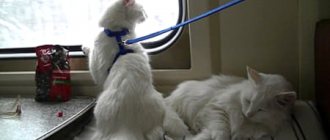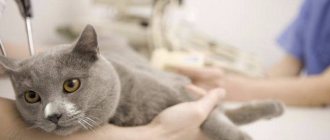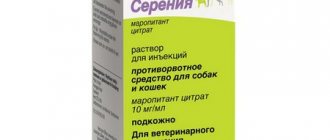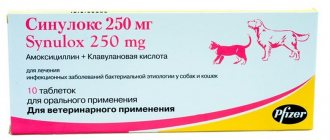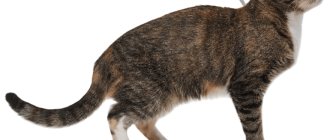Cats are amazingly graceful and freedom-loving creatures. But despite their independence and a certain waywardness in behavior, they are incredibly sensitive and vulnerable animals. There can be many reasons for stress in cats: a trip to the veterinarian, the arrival of a new tenant in the apartment, moving to a new place, being on the road. And it doesn’t matter at all whether this journey turns out to be several days long or an hour-long trip to grandma’s dacha: the animal will worry and experience stress from being in an unfamiliar environment. Of course, there are unique “specimens” of adventurous cats that perceive any movement in an unfamiliar space with joy. However, this is rather the exception that proves the rule: cats have a hard time on the road. A sedative for cats can come to the rescue in such situations. You definitely need to take it on the road.
Why can a cat feel stressed on the road?
For the most part, animals, and cats are no exception, obey the natural instinct of self-preservation. The main principle of this instinct is the ability to control the situation and anticipate danger in time. And four-legged pets can easily cope with this task within the walls of their home - where all the objects and corners have long been studied, the smells are familiar, food and water are within visible limits, and the place to sleep has been agreed upon with the owners. Another thing is the situation while traveling. It can be difficult to manage without sedatives for cats on the road. After all, almost everything, from unfamiliar smells and sounds to the basic uncertainty of its future, frightens the animal. If, in addition, the cat is sensitive by nature or has recently suffered from an illness, then the stress will be even greater. An important factor is the habitat of the furry traveler - if the cat lives in a private house with the opportunity to go outside, then the trip will not be such a severe test. And on the contrary, in the case when the animal did not go further than the staircase, any movement outside will lead it to a state of nervous excitement.
When you might need a sedative
global $ads_google;
//data-ad-slot=”2475549904″ $ads_google = empty($ads_google) ? false : true; ?> if ($ads_google == false) {?> $ads_google = true; ?> } ?> A sedative should not be used without good reason. If there is a chance to calm the cat in another way, it is better not to resort to drug intervention, even one based on a phytotherapeutic effect. The stress that the cat experiences from the arrival of guests could be neutralized by purchasing a soft house, in the niche of which the animal will feel protected. You can make such a house with your own hands.
In the cases described below, you may actually need the help of sedatives.
Mental disorders
Outwardly, such violations manifest themselves in endless licking of the fur, which can even lead to its thinning. The skin under the fur looks irritated from constant contact with saliva and tongue. In addition, the cat may hunt for a non-existent target, twitch and jump for no reason, and constantly meow unmotivated.
Transporting a pet
During transportation, especially when the cat is not accustomed to this from early childhood, the animal may become stressed. If in a car the problem comes down only to a new way of moving, then public transport can easily cause panic in the cat. You will have to focus on your pet; there are also those who are just happy to go for a ride.
If the standard behavior changes, it will have to be corrected with medication. When planning a move, it is better to give your pet medicine in advance, especially if the instructions for the sedative drug say that it has a cumulative effect. It is better to learn in advance how to properly transport cats in a carrier.
Stress
Stress occurs for a number of reasons, including part of mental disorders and the circumstances of the pet’s living conditions. In many cases, it is better to consult a specialist and find the cause of the stressful condition. Probably, if you eliminate it, you won’t need to take medications.
Grooming
Grooming is highly valued by owners, but animals are not always as happy as visiting exhibitions. If large-scale procedures are planned, you can treat the cat with sedatives.
Castration
Castration and sterilization, as a surgical intervention in the body, also cause the cat to experience serious stress, both on the physical and mental level.
global $ads_google; //data-ad-slot=”2475549904″ $ads_google = empty($ads_google) ? false : true; ?> if ($ads_google == false) {?>
$ads_google = true; ?> } ?>
Aggression
Fear, anxiety, and phobia can result in aggressive behavior. Aggression that is not typical behavior must be corrected.
Estrus
Against the background of estrus, aggression and hypersexuality may also occur, which can be very difficult to tolerate. Activation of the sexual instinct affects the well-being of pets, sometimes causing them to actually suffer.
Advice from veterinarians before traveling
There are several simple recommendations for owners that will help reduce the level of anxiety of the animal. So:
- Cats, as mentioned above, are very perceptive and sensitive creatures. They literally read the mood of their owner. Therefore, before the trip, you need to remain calm: you should avoid fuss when packing your things. Excessive emotionality and excitability will instantly be transmitted to your furry friend. The best solution would be to gradually collect things and not rush.
- It is necessary to take care in advance about choosing a sedative for your cat on the road. It is advisable to give preference to one or another drug after visiting a veterinarian and receiving his recommendations. Reading owner reviews will be a big help.
- Special attention should be paid to the cat carrier - it must be made of high-quality materials and match the size and weight of the animal. If the carrier is not used for the first time, then there are probably odors and animal fur left in it - this will make the task of staying in it easier. If the cat is traveling for the first time, then it is worth putting the purchased house for the road in a visible place so that she can properly examine it.
- It is worth taking care of the animal’s nutrition on the road. There is a possibility that due to stress, the cat will completely refuse to eat. However, food and water should be on hand. Experts also advise bringing your furry friend's favorite treat with you.
- If your cat has a favorite toy or personal bedding, be sure to take it with you on the road. These pieces of home will give you confidence in stressful situations.
Manifestations of anxiety
Nervous behavior
These signs of fear can be misinterpreted by inexperienced owners: when the cat is under severe stress, it tries to calm itself down by grooming or even purring. In this case, licking the fur is hasty; often the animal becomes fixated on one area (paw, side), where baldness occurs due to this (self-induced alopecia).
Appetite changes - from complete indifference to food to bouts of gluttony. Sometimes it becomes perverted - the cat begins to chew inedible objects or indoor plants.
Trying to hide
If a cat is frightened by something specific - loud noises, an unfamiliar place, a person or a dog, the natural reaction of a small predator will be to flee. The animal will look for a secluded and protected place, so they often hide under the bathtub, under the bed, or in the closet.
Aggression
Depending on the cat's temperament and circumstances, a frightened cat can turn into extreme aggressiveness. An affectionate furry pet in a state of passion turns into a crazy creature with claws and fangs, terrifying its owners. Cats fight for their lives much more selflessly than dogs. Another question is that their lives are often not in danger: the bitter anthelmintic is not a deadly poison at all, and the explosions outside the window are just festive fireworks.
In dominant individuals, aggression may be associated not with fear, but with territorial behavior: a cat can rush at a dog or another cat if it is confident in its abilities, and sometimes even at a child if he provokes the animal.
External signs of an aggressive attitude:
- The cat tries to appear as big as possible: arches its back, its fur stands on end (especially on its back along the spine), its tail fluffs out.
- The animal howls threateningly, hisses and snorts, grins.
- The pupils are constricted, the gaze is fixed on the object.
- The tail whips at the sides and twitches.
- The cat hits with its front paw when trying to get closer.
Panic
If the animal is unable to either defend itself or escape, then instead of humility and submission, a panic attack should be expected. The cat can make heartbreaking screams, saliva flows profusely, like foam, involuntary urination occurs, and sometimes defecation occurs.
External signs of fear:
- The cat freezes, presses itself to the floor/table, cowers (pulls its tail and paws under itself).
- The pupils are dilated, the cat hides its eyes and does not look at the person.
- Ears are pressed to the head.
Herbal preparations: methods of use
The most popular sedatives for cats in this category are:
- "Fitex" (liquid for instillation). Contains medicinal herbs. This product should not be used if your pet has low blood pressure. Give 3-5 drops in the morning, afternoon and evening. Can be added to food provided it is completely eaten.
- “Stop Stress” (drops) – calming drops for cats. Similar in composition to the drug "Fitex", but also contain phenibut. Used at the rate of 1 kg of animal – 1 drop of product. It should be given in two doses.
- "Cat Bayun" (tablets and infusion). They contain only plant substances and can be given to cats from 10 months. The result is achieved after 5-7 days of use.
- “Fospasim” (liquid for injections and drops). The drug is quite fast acting. Consists of medicinal herbs and mineral components. Injections are administered subcutaneously or into the muscle at a rate of 0.1 ml per 1 kg of animal weight. Drops – 10-15 drops 1-2 times a day. The course lasts about 10 days.
- “Feliway” (in the form of a spray or a bottle with a substance for connecting to an outlet). Its distinctive feature is that it contains pheromone F. The drug is odorless and colorless. Non-toxic.
Rules for taking medication
You should start giving your pet medicine 2-3 days before moving, before:
- do not feed 12 hours before transportation;
- if the journey is long, reduce food portions;
- boiled water – do not limit.
The injections are given by a veterinarian. They give injections on their own with the doctor’s permission, strictly observing the dosage of the medicine:
- the animal is immobilized using a towel;
- slightly pull back the withers;
- The needle is inserted with a quick movement and the medicine is injected.
Medicines in the form of tablets, drops, powder are given with food. The tablet is crushed, mixed with food, and fed to the pet.
For an animal that has been given a sleeping pill before moving, good sleeping conditions are created:
- the cat should lie freely;
- the muzzle is turned to one side;
- to prevent the pet from vomiting when rocking, provide access to fresh air for breathing;
- cover with a light blanket.
The dose of sleeping pills depends on the duration of transportation and the animal’s resistance to stress.
It is prohibited to give animals sedatives intended for humans.
Drugs with chemical composition
These products can only be used after consultation with a veterinarian and after prescribing the required dosage for each specific cat. They have quite a few contraindications and are used exclusively in emergency situations:
- Buspirone (tablets). An effective remedy for combating stress in cats. However, the effect of the medicine does not begin immediately, but after several weeks of use (about a month). It has the effect of accumulating in the animal’s body. Prescribed for phobias in animals.
- Diazepam is a strong tranquilizer. It quickly calms and relieves aggression in cats, but has a number of contraindications.
- "Vetranquil" (liquid for injections). Very quickly calms down, eliminates excitability and nervousness of the animal. Begins to act in a few minutes.
- "Amitriptyline" (liquid for injections). Used for injection into the muscles and veins of the animal. Has a strong sedative effect. Relieves aggression and severe stress in cats. It works quickly. It has a number of contraindications.
- "Xylazine" (liquid for injections). Has a strong sedative effect. It starts working in a few minutes. It will help relieve the animal’s strong excitability, aggression, and tension. It has a fairly large list of contraindications.
Recommendation for using sedatives for cats on the road
It should be remembered that when choosing a sedative for your furry friend, you need to take many factors into account. You should put the well-being and individual characteristics of the animal first and only then focus on ease of use. Drugs containing chemicals can cause allergies in a cat, so they should be given with caution after making sure your pet is healthy. Products containing components of plant origin are more preferable. However, they can also cause side effects. Therefore, it is worth starting to give them gradually, in small dosages. And, only after making sure that the cat is in good health, continue the course of taking this type of sedative for cats on the road. Often, the effect of homeopathic remedies begins after 1-2 weeks of use.
Mechanism of action
Experts divide sedatives for cats into 2 types: homeopathic and chemical. Regardless of the principle of action of the product, its effect is aimed at:
- pressure correction;
- beneficial effect on the nervous system;
- suppression of feelings of fear;
- Relieving tension.
Calming for cats on the road: reviews
When choosing a sedative for a cat, many owners are prejudiced against drug reviews on the Internet and do not pay attention to them. There are two sides of the coin: on the one hand, each animal is individual and it is difficult to say in advance what will suit it best. On the other hand, there are drugs with a majority of positive votes, and accordingly, trust in them may initially become higher. In general, reviews about sedatives of herbal origin are good, the owners are satisfied with the results. As for products containing chemicals, the best alternative to choosing a drug, according to reviews, would be a personal consultation with a veterinarian who can accurately calculate the dosage and answer any questions that concern you. It should be remembered that each animal is individual and has a number of distinctive character traits.
Side effects
Uncontrolled use of sedatives causes addiction and a number of side effects. These include:
- redness of the skin, itching and hair loss;
- nausea and vomiting;
- bloating and diarrhea;
- tachycardia and hypotension;
- runny nose and increased tearfulness;
- drowsiness.
Despite the fact that sedatives for cats have a calming effect on the body, in some cases the effect of their use may be the opposite. If treatment with sedatives only worsens anxiety and irritability, then it should be discontinued.
Contraindications to the use of sedatives
Do not forget that any remedy, even homeopathic, has a number of contraindications. Therefore, it is still worth giving certain medications, as mentioned above, after consulting a veterinarian. In addition, the use of sedatives during pregnancy, feeding kittens, and under the age of one year will be absolutely prohibited. Contraindications for health reasons include: renal or genitourinary pathologies, problems with blood pressure and vision, periods of illness of the animal. Also, under no circumstances should you give such a popular valerian to cats. Along with catnip, it causes narcotic intoxication and harms the health of the animal.
Handy sedatives: how else to help your four-legged friend
Don’t forget that your furry pet, although it sometimes behaves willfully and excessively mannered, depends on warmth and affection. Especially in a stressful situation, when everything familiar is replaced by the unknown and dangerous. Simple stroking and tickling behind the ear will reassure the animal. Warm words of support, spoken in a cat’s native voice, will be a powerful help in the fight against nervous tension. And it doesn’t matter that the meaning of the words will be incomprehensible to the cat - the intonation with which they are spoken, the emotional message, is much more important. After all, only the owner knows how to caress and cheer up his furry friend. And, of course, do not forget about calmness - the animal will intuitively convey the state of its owner. It may be worth taking care not only of a sedative for your cat on the road, but also in case of stress and poor emotional well-being while traveling, purchase a human sedative. Have a pleasant journey and good mood along the entire journey to both the owner and his furry pet!
How to calm a cat if it is aggressive
Some cat breeds can be aggressive due to their nature. There are two options here: choose your pet carefully or learn to live with it. Read about what breed of cat to choose for your apartment in my other article, and I’ll tell you below how to live with manifestations of aggression.
Identify and remove the irritant. This could be household appliances, the presence of another animal or a small child in the room. If this is the reason, isolate them from each other and read my article on how to make friends with cats.
Leave the animal alone for 15-20 minutes. Usually this time is enough to calm down. Do not disturb your pet if he is enjoying peace.
Create a positive atmosphere. Don't focus all your attention on the animal. It is enough to speak kindly to him from time to time or hum something quietly. Cats respond well to melodic sounds, so you can use the voices of nature, the purring of kittens or calm music as the background.
If aggression is caused by a desire to defend itself, you need to give the animal confidence. Approach the cat, sit quietly next to it (you need to be on the same level) and wait until the pet pays attention to you. Gently extend your hand towards the cat with your open palm facing up. Perhaps the animal will make contact on its own. If this does not happen, do not impose and move away.
When aggression occurs on a regular basis (for example, towards strangers), keep a spray bottle ready. Water will scare away the pet and prevent it from harming guests.
